As societal norms and workplace attitudes continue to shift, the property and casualty (P&C) insurance space has been significantly impacted by a phenomenon known as social inflation. This trend has presented challenges for insurers, actuaries, and risk managers alike, leading to increased costs and complexities in compliance and managing risks. In this article, we delve into the concept of social inflation, explore current trends, and discuss strategies that employers can employ to address its effects effectively.
Background
For the purpose of this article, social inflation refers to the rising insurance claim costs above economic inflation due to societal and legal trends that increase the dollar amount of claims settlements and judgments. It encompasses various factors, including evolving attitudes toward litigation, changing legal interpretations, and increasing jury awards. For instance, more employees are seeking legal counsel to resolve workplace-related issues and asking for higher settlements than in the past. Several underlying elements that contribute to social inflation include:
- Litigious Culture: Society’s growing propensity to turn to litigation as a means of workplace conflict resolution has fueled an increase in the frequency and severity of insurance claims.
- This phenomenon is playing out across multiple lines of coverage including Workers’ Comp, Employment practices liability insurance (e.g., employee misconduct, sexual harassment, wrongful termination, etc.) professional/general liability, and auto (both individual and commercial). It is important to note as litigiousness varies by state/region so does the impact of social inflation on insurance cost between two different locations.
- Judicial Trends: Courts’ and jury’s decisions and interpretations of laws, particularly regarding liability and compensation, have become more favorable towards claimants, resulting in larger settlements and verdicts.
- Economic Factors: Economic downturns or uncertainties may prompt individuals to pursue legal avenues for financial security, adding to the volume of claims and the pressure on insurers to settle.
- Media and Advocacy Influence: Public perception and media coverage of high-profile cases can shape attitudes towards compensation and influence jury decisions, potentially leading to inflated awards.
- Litigation Funding: Third-party investors may provide litigation finance to plaintiffs, driving up pressure to prolong lawsuits and possibly resulting in higher awards and increased legal expenses.
The combination of these factors has created a challenging environment for insurers and businesses, leading to increased premiums and retained losses for the insured and reduced profitability, and greater uncertainty in estimating future liabilities for the insurance carriers.
Social Inflation’s Impact on the Market
Here are some ways social inflation has been impacting P&C markets:
- Rising Claims Costs: Insurers have experienced a notable uptick in claims costs across various lines of business, including auto liability, general liability, and professional liability.
- Increased Frequency of High-Dollar Claims: There has been a noticeable increase in the frequency of large claims and multimillion-dollar settlements, particularly in cases involving bodily injury, property damage, and product liability.
- Erosion of Underwriting Profitability: Social inflation has contributed to declining underwriting profitability for many insurers, as higher claim payouts outpace premium revenue growth therefore many carriers were forced to take large rate increases.
- Reserving Challenges: Insurers face challenges in accurately reserving for future claim payments, given the uncertainty surrounding the magnitude and frequency of social inflation-driven losses.
These circumstances underscore the need for proactive risk management strategies to mitigate the impact of social inflation on businesses and insurers alike.
Addressing Social Inflation: Strategies for Employers
In today’s dynamic business environment, where the landscape of P&C insurance is continually evolving, addressing social inflation has become a paramount concern for employers. Failing to acknowledge and mitigate the impacts of social inflation can lead to significant financial ramifications and operational disruptions for businesses of all sizes and industries.
- Risk Identification and Assessment: Employers should conduct comprehensive risk assessments to identify potential exposures to social inflation-driven claims. This involves analyzing industry trends, historical claims data, and emerging legal developments to anticipate future liabilities.
- Risk Optimization: Employers can explore alternative risk transfer mechanisms, such as captive insurance or excess liability coverage, to mitigate the financial impact of large claims and volatile insurance markets.
- Investment in Loss Prevention and Safety Programs: Proactive investment in loss prevention and safety programs can help reduce the frequency and severity of insurance claims, particularly with lines like workers’ compensation and auto. These programs, or lack thereof, will be imperative in claims settlements.
- Contractual Reviews and Protections: Employers should review and update contractual agreements to include indemnification provisions, liability limitations, and alternative dispute resolution mechanisms to mitigate the risk of costly litigation and claims disputes.
- Engagement with Legal and Insurance Partners: Collaboration and alignment with legal counsel and insurance partners is essential for staying informed about evolving legal and regulatory trends and developing effective risk management strategies tailored to the organization’s specific needs.
Social inflation poses significant challenges for insurance providers, businesses, and risk management teams. This requires a proactive and multifaceted approach to risk management, risk assessment, and corporate risk profile to adapt as the forces behind social inflation are constantly shifting. By understanding the underlying drivers of social inflation, monitoring industry trends, and implementing effective risk mitigation strategies, employers can better navigate this landscape and safeguard their financial stability in the face of uncertain liabilities.
As Captive International and Spring share the same birthday (March 24th), here is a collaborative Q&A with our leadership team. Some of the topics discussed include the progression of the captive industry, market challenges and future opportunities.
As Captive Review celebrates its 25th birthday, they have released a list of the 25 most influential people in the captive space in the last 25 years. Our Managing Partner, Karin Landry was featured in their list for her expertise in risk management and alternative risk financing solutions. You can find the full article here.
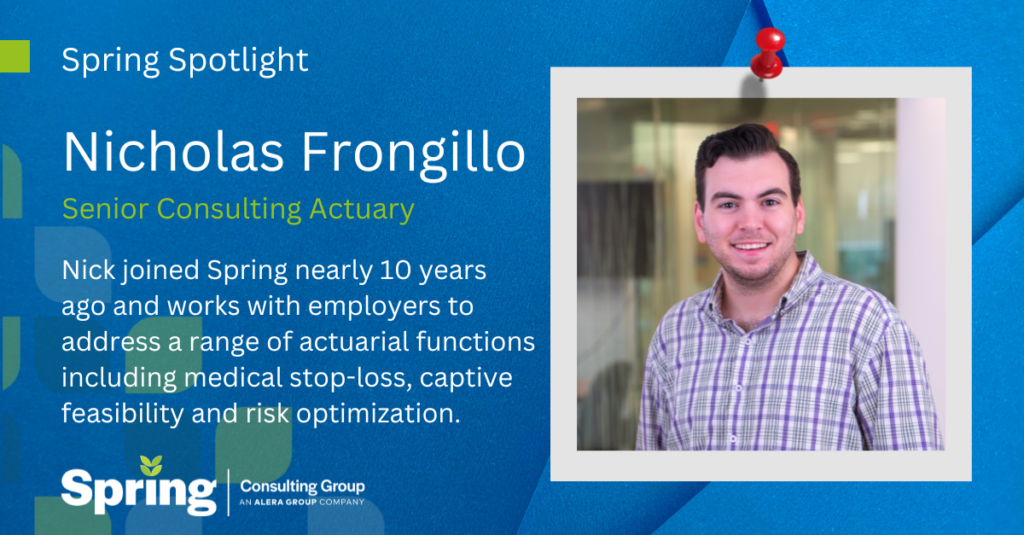
Title:
Senior Consulting Actuary
Joined Spring:
I joined Spring in May 2014, shortly after graduating from Northeastern.
Hometown:
Central MA
At Work Responsibilities:
My actuarial focus is mainly health and medical stop-loss.
Outside of Work Hobbies/Interests:
Sports
Fun Fact:
I’ve been known to card count.
Describe Spring in 3 Words:
Never a dull Moment!
Favorite Movie/TV Show:
Inception/Seinfeld
Favorite Food:
Cheese
Favorite Place Visited:
Italy
Favorite Band/Musician:
Changes by the day!
If You Were a Superhero, Who Would You Be?
Batman.
Name One Thing On Your Bucket List:
Retire
What is One of Your Proudest Moments?:
I don’t know that I have any singular big ones, but I am proud every time we get positive client feedback
If You Win the Lottery, What is the First Thing You Would Do?
Invest!
What are You Passionate About?
Financial Literacy
Spring’s Senior Vice President, Prabal Lakhanpal will be presenting at Business Insurance’s World Captive Forum on January 25, 2024. His session will cover new emerging risks and provide tactics for improving captive risk distribution frameworks. You can find the full update here.
With winter quickly approaching, the Cayman Captive Forum last week provided a great escape from the cold weather and a fantastic excuse to visit a tropical paradise. As Cayman is the second largest captive domicile (behind Vermont), it is more than a vacation spot; a rewarding opportunity to address top trends and practices in the captive insurance and risk management space. Here are some driving topics of interest this year:
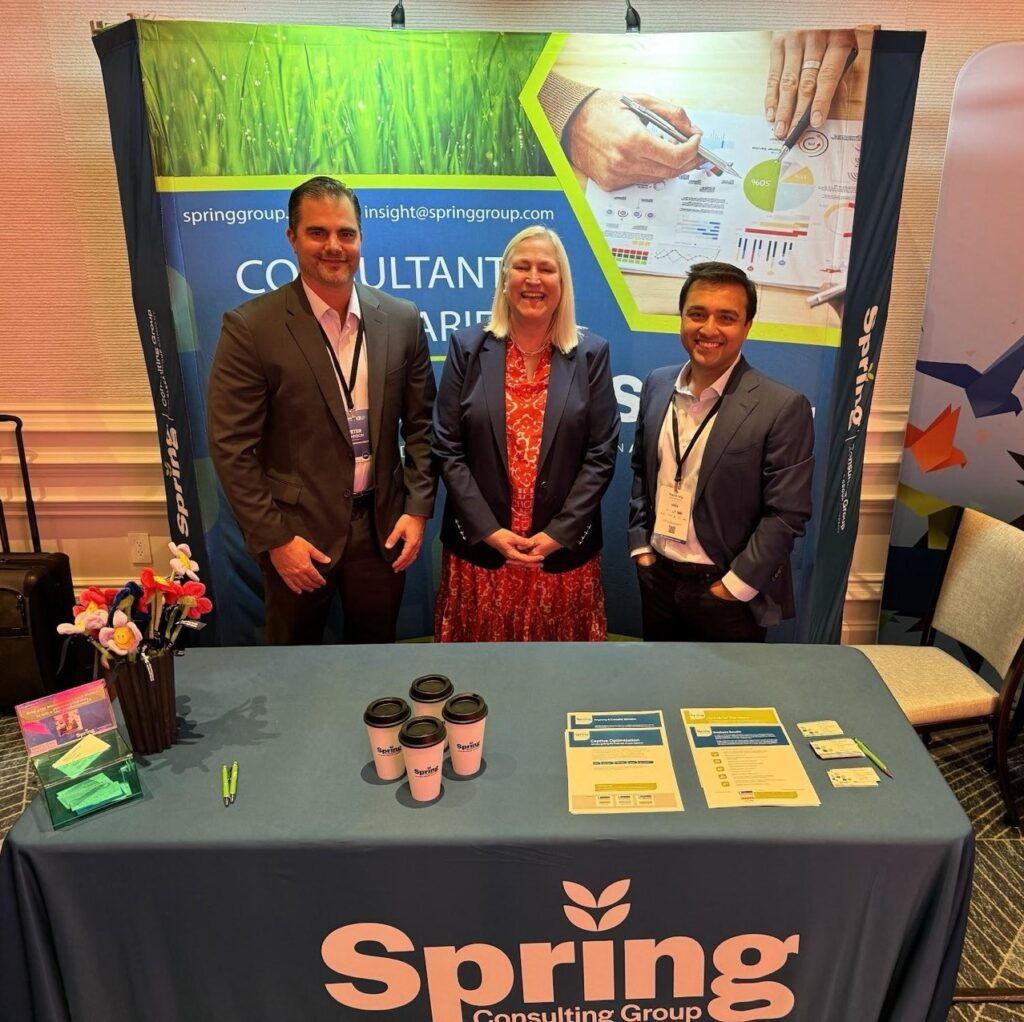
AI and Risk Management
As concerns surrounding artificial intelligence (AI) dominate headlines and conversations worldwide, it was only fitting that it was a popular topic of discussion this year at Cayman. AI holds an interesting position in risk management, in that it can be used to help identify risks and create efficiencies; but also can create vulnerabilities in cyber and digital. Here are a couple of innovative sessions on AI’s impact on risk management:
– During the presentation “AI and your Captive,” beverage distributor, Southern Glazer’s Wine and Spirits explained how they were able to optimize their captive using AI and machine learning tools.
– In the eye-catching session, “Chat-GPT/AI Concerns in Claims/Risk Settings,” risk experts reviewed how AI is being used in cyberattacks, especially towards healthcare organizations. They also examined the recent emergence of AI chatbots in healthcare.
Cyber Risks
This year there have been over 327 healthcare data breaches reported to the US Department of Health and Human Services, involving more than 40 million patients’ data1. Cyber is a top priority for risk managers, especially those working for healthcare employers. Here are some highlights:
– The session, “Complex Cyber: Renewal to Claims” looked at current cyber insurance market trends for healthcare organizations and recommendations for protecting patient information from adverse incidents.
–With emerging technologies, cybercriminals have more tools than ever at their disposal. A presentation titled “Cybersecurity Trends and Tomorrow’s Challenges: Future-Proofing Your Organization” highlighted strategies to combat evolving cyber threats.
Risk Face by Healthcare Organizations
As Cayman is the largest domicile for healthcare organizations2, healthcare-related risks receive a lot of buzz each year, and 2023 was no exception. Healthcare organizations face unique challenges, some of which include:
a) Social Risks
Within the healthcare sector, risk management teams must balance distinctive social and legal issues on top of day-to-day operations. Some noteworthy sessions included:
– The presentation, “The Impact of Social Inflation on Captives and Others,” reviewed shifting trends in medical professional liability and explored how risk management teams can better understand changing social influences and the risks tied to them.
– One engaging session entitled, “Reproductive Care Post-Dobbs: Protecting Patients and Providers,” provided insights into how a healthcare organization was able to identify emerging risks associated with reproductive care.
b) Workplace Safety and Medical Malpractice
With unique risks come unique coverages. Healthcare organizations often must turn to specialty insurers and experts to evaluate risks associated with workplace violence and medical malpractice. These topics were widely discussed during the conference:
– In the one-of-a-kind session, “Active Shooter Workplace Violence – Claims Coverages Consequences,” the Captive Owner from the University of Pittsburgh Medical Center drew takeaways from their mass shooting over a decade ago.
– A session on “Implementing Structured Communication Processes to Avert Malpractice Claims & Reduce Patient Harm” spotlighted how nearly half of malpractice claims come from miscommunication and provided suggestions on streamlining communication.
– The final session of the conference “People Behaving Badly” reviewed a high-profile case where medical providers harmed patients and professional liability considerations for healthcare companies when disciplining or terminating staff.
c) Other Priorities
In addition to the topics discussed above, some other notable healthcare industry-focused sessions included:
– As virtual care continues to be popular post-pandemic, a group of risk experts discussed recommendations for “Managing the virtual practice of medicine in multiple states & the unique risks associated with this practice.”
– In a virtual session, “A total guide to total cost of risk,” an actuary and captive consultant discuss how to properly calculate and identify Total Cost of Risk (TCOR) and suggestions on how to adjust to changes in TCOR.
The Cayman Captive Forum was a strong finish to the year in terms of lessons learned and connections made. The farewell beach party is always an added bonus! We welcome this chance to reflect back and look forward to what 2024 has in store for the captive space.
1 https://www.urologytimes.com/view/health-care-cyberattacks-soaring-in-2023
2 https://caymanintinsurance.ky/about/
As Seen in Captive International’s Cayman Focus 2024
Total cost of risk (TCOR) is a buzzword in the insurance space, but it is a metric that carries significant operational weight, and can mean different things depending upon the organisation. There is no tried and true approach to TCOR, but we have gleaned valuable insights after consulting on the topic across a range of companies and risk profiles.
Leveraging those insights, we are sharing here a foundation for framing TCOR at your organisation, keeping in mind common dos and don’ts we have come across.
What is TCoR?
It’s important to start at the beginning. While there are various definitions out there, the International Risk Management Institute (IRMI) states that TCOR is the sum of all aspects of an organisation’s operations that relate to risk, both the cost of managing risks and the cost of losses incurred. These costs typically fall into the following categories:
- Retained (uninsured) losses and related loss adjustment expenses
- Risk control costs
- Transfer costs
- Administrative costs
More sophisticated risk management programmes may have internal risk control costs, whereas for other organisations these may be embedded into what is paid to a carrier with the goal of controlling loss.
Commercial insurance premiums are a prime example of a TCOR driver, representing what you are paying to transfer certain costs to the commercial or reinsurance market. Even for organisations with a captive, which is known to save organisations money in the long term, a risk transfer premium is still happening from the parent company to the captive.
Further, whether or not a captive programme is in place, most companies, especially those on the larger side, still retain a portion of their risk on their corporate balance sheet (eg, cyber deductible).
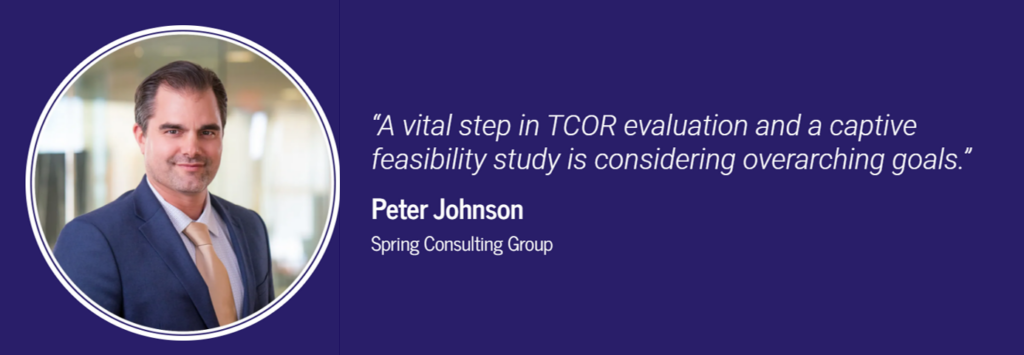
Building your TCoR
What constitutes TCOR varies across industries and company but regardless it can be backed by sophisticated risk management models as well as simpler calculations.
From a broad perspective, commonly overlooked considerations when it comes to tracking TCOR include:
- Beyond the frictional carrier or captive out-the-door premiums, other items budgeted for on the insured side such as safety programmes, loss control, and bonus programmes should be evaluated for inclusion or exclusion. If they are tracked within a captive premium (as is typically the case with loss control), such items are captured already so a company needs to be cognisant of not double-counting.
- Investment and underwriting income. Generally captives are priced to earn underwriting income and also earn investment income on the held assets to pay for unpaid claims. This income should be accounted for, which results in a lower TCOR.
- Softer costs such as risk management or safety personnel should be assessed for inclusion. Overall, consideration beyond obvious face-value expenses and including ancillary factors across the company provide a more robust calculation. Actuarial estimates of claims should be utilised for validation. Avoid relying solely on loss runs as this creates volatility because the third-party administrator (TPA) is typically only booking case reserves in the incurred claim estimates without factoring in the actuarial incurred but not reported development.
- Evaluation dates and look-back periods provide for quality tracking and the generation of trends, and should be assessed at various points in time. This is important when trying to compare the costs of various programmes related to budget and cash flow.
Perhaps most important is the need for year-over-year consistency regarding what is included in TCOR and what is excluded.
Who uses TCOR?
TCOR is meaningful to different stakeholders depending on the company, but these key audiences have important use cases for TCOR as follows:
- Risk managers leverage TCOR to show how they are approaching risk management and demonstrate how the company should retain risk, either through a captive premium or another method, as well as recommend what portion of risk should be transferred.
- Finance/accounting departments use TCOR to stress test and illustrate how much the organisation can afford and then plan for budgetary items that should reduce stated risk.
- Property and casualty (P&C) brokers care about TCOR because it enables them to benchmark and perform retention analyses in order to optimise programmes and mitigate volatility for their clients. TCOR allows them to make an apples-to-apples comparison year over year.
Trends and best practices
TCOR should not be touted simply because it sounds good. It needs to be grounded in analytics, formal reviews, and comprehensive reporting that outlines how TCOR is arrived at and what it means for your organisation. For large companies, TCOR may be factored into bidding, procurement, and contract processes. For smaller companies, there may not be enough critical mass to validate a self-funded approach, which means you’re more susceptible to market conditions and capacity.
From an organisational standpoint, TCOR plays a significant role in (i) accountability and compliance; (ii) making sure all assets, certificates of insurance, and contracts are listed; (iii) employees are accounted for; and (iv) there are no gaps in coverage that could change TCOR unexpectedly at the end of the year.
A vital step in TCOR evaluation and a captive feasibility study is considering overarching goals. If your company is looking to stay at cost, then moving to a captive may not always be the best play and you may be better off in the commercial market. This is why, as part of a TCOR analysis that is embedded within a feasibility study process as a means to reduce risk, alternative retentions in the market should be evaluated and the different scenarios to determine whether or not a captive makes the most sense outlined.

Other pieces of TCOR wisdom we have gathered over the years include:
- Fluctuations will happen from year to year, but some of the more volatile components are captive income and retained claims.
- A common misconception is that by increasing retention, lowering limits, or both combined, a reduction in TCOR will automatically occur. This may be true but is not necessarily so, as these practices could also expose the company to more risk than anticipated and that loss potential may not be appropriately projected.
- Consider this: with cyber and umbrella coverage becoming expensive for companies, let’s say you drop cyber entirely and lower limits to reduce TCOR by 5 percent. But then there’s a $3 million loss within that layer that would have been covered by policies you no longer have, so even though your budgeted TCOR went down by 5 percent, your realised TCOR increased by 10 percent due to the new loss.
- Analysis should consider different scenarios: what could happen, versus a straight-line evaluation.
- Ensure that at the time of increasing or decreasing a limit or removing a policy altogether, all parties agree to this move and it is documented to avoid questions after the fact.
- Benchmarking TCOR should be taken with a grain of salt, as practices are varied and factors such as captive versus no captive, geographic risk class differences, treatment of risk management admin costs, inflation and payroll may be working behind the scenes and can prohibit a direct comparison between two different organisations.
Conclusions
TCOR is complicated, but it is important to take a wide view of all the pieces of the puzzle, and then find the correlations and mitigation strategies available through the buying process. Captives need to understand how to budget for TCOR, how to build it at your organisation, and then how to interpret it year over year.
Strong TCOR practices can lead to improved risk management, smoother claims processes, and overall lower costs, especially for growing companies. A thoughtful TCOR approach serves to unify all your insurance stakeholders, from risk managers to CFOs, in understanding insurance spend and ultimately the total cost of risk.
Captive International has released the winners for the 2023 US Awards. Spring is proud to announce that our Managing Partner, Karin Landry won the Best Feasibility Study Individual. We were also highly commended for Best Actuarial Firm, Top Feasibility Study Firm, and Top Captive Consulting Firm. Our team was also highly commended for the following: Best Individual Captive Consultant (Karin Landry & Prabal Lakhanpal), Best Individual Feasibility Study (Prabal Lakhanpal) and Best Actuary (Peter Johnson & Nick Frongillo).



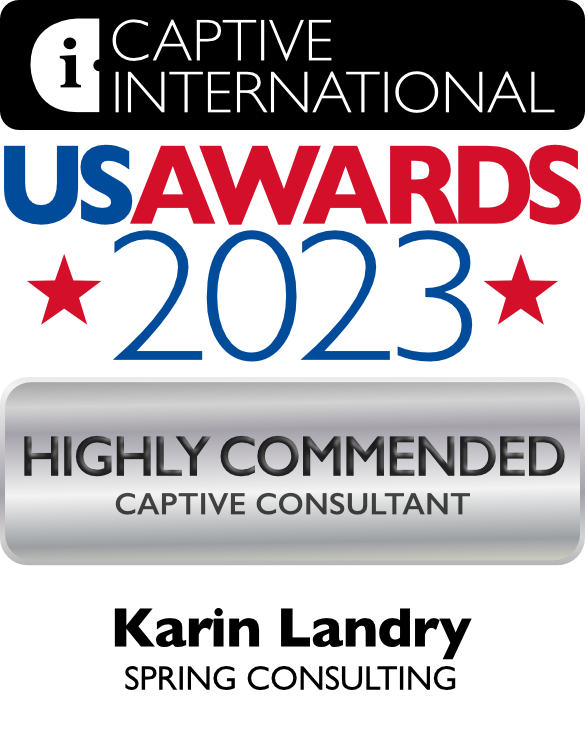

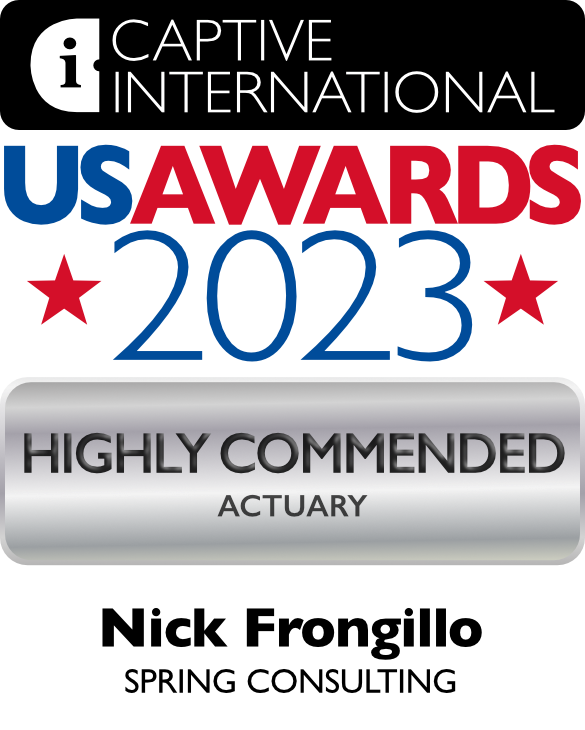
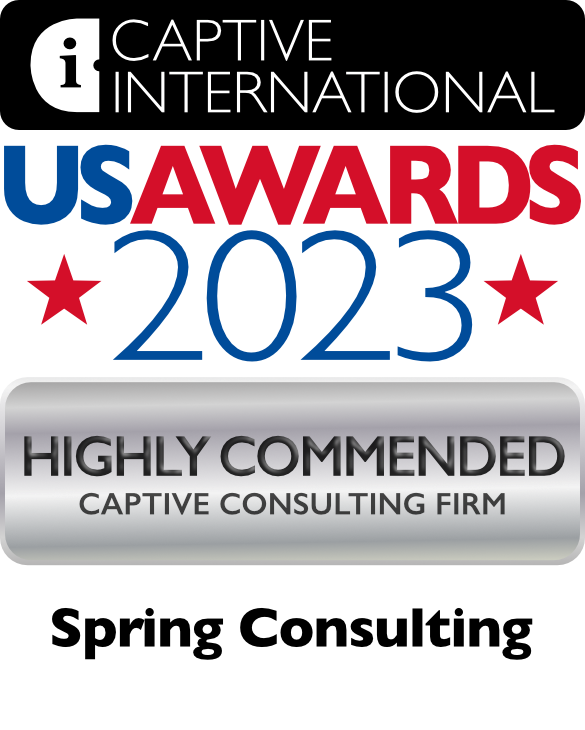
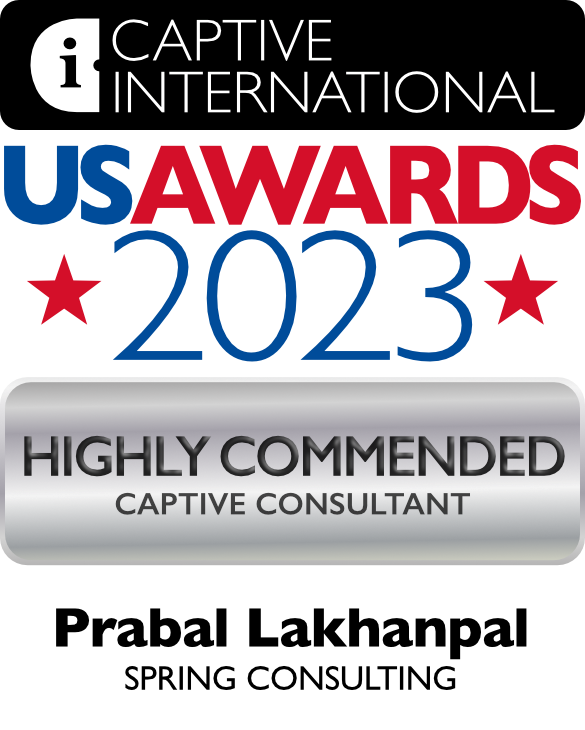
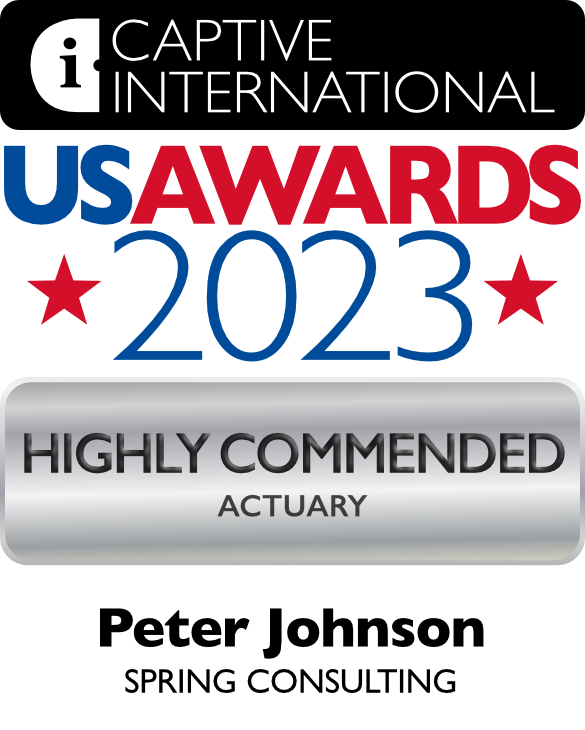
Spring has been recognized as one of the Top Employee Benefits Consulting firms in Massachusetts by Mployer Advisors, who focus on connecting employers with top-rated insurance advisors. We’d also like to congratulate our colleagues at Boston Benefit Partners, An Alera Group Company, for making the list as well! You can find the full update here.